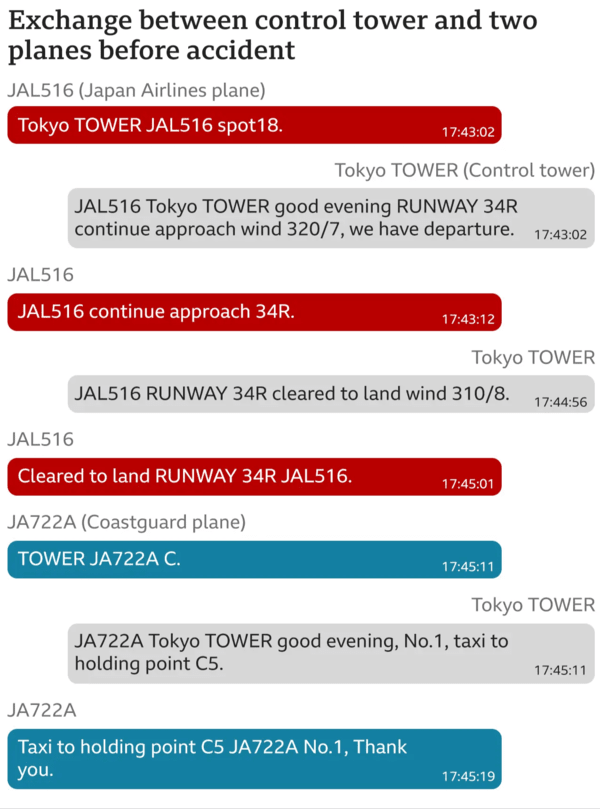Iran’s Plan to Strike Back Against the U.S.
Iran’s Military Preparations Following U.S. Attacks
Loading...
The pilots of a Japanese plane that collided with a smaller plane at Tokyo's Haneda airport were initially unaware that their plane was on fire.
A flight attendant informed the cockpit of the fire in the cabin, a Japan Airlines spokesperson told the BBC.
The evacuation of all 379 passengers aboard Japan Airlines Flight 516 then proceeded with life-saving precision.
Five of the six people aboard the Coast Guard's smallest aircraft, a Bombardier Dash-8, were killed.
“Immediately after the plane landed, the pilot felt a sudden jolt and lost control to stay on the runway. A fire broke out, but the pilots did not initially recognize it and learned about it from the flight attendant,” the JAL spokesperson said.
There were three pilots and twelve flight attendants on board when the incident occurred. The plane's announcement system was damaged, forcing the crew to use only megaphones and their voices to shout instructions.
“The first thing the flight attendants did [after realizing that some passengers had realized their plane was on fire] was to make them stay still and not get up, which could make escape very difficult. The paging system was unusable, so these instructions were created without it."
Japanese media described the evacuation as a “miraculous 18 minutes.” Passengers ditched their carry-on luggage, ran toward the emergency exits, and slipped out of the plane before it caught fire.
"[As] smoke entered the cabin and spread...flight attendants began shouting at passengers, saying, 'Leave your stuff!', 'Take off your high heels' and 'Head down'", said the spokesperson.
Their "cooperation (...) was essential to ensure that all passengers escaped quickly and safely", they added. Japanese authorities said on Wednesday that the Coast Guard plane had not been authorized to take off from the Haneda runway. The plane will deliver humanitarian aid to the areas affected by the earthquake.
According to officials, the JAL flight was cleared to land on runway 34R in Haneda. At the same time, the Coast Guard aircraft was ordered to "taxi to holding point C5" - a location on the airport's taxiway system where planes await authorization to enter the airport. active track.
The transcript shows that the Coast Guard aircraft responded to an air traffic call to taxi to the holding point, the last transmission before the collision.

The transcripts contradict the Coast Guard plane's captain—the only one of the six crew members to survive—who told investigators that he had been cleared to enter the runway the JAL plane was approaching. The VOU also found information suggesting that the array of lights at the holding spot in question may not have worked. But experts point out that there are other visual cues, such as painted signs that would indicate where planes should stop before the runway.
The well-rehearsed scenes on the Japan Airlines plane stand in stark contrast to plane evacuations that do not strictly adhere to safety protocols.
In 2016, an Emirates Boeing 777 crashed in Dubai and video footage showed chaotic scenes of passengers trying to grab luggage as they fled to emergency slides. The crew were praised for their efforts in evacuating passengers and fortunately, all 300 passengers on board the flight to Dubai survived. Tuesday's incident is the first serious accident involving an Airbus A350, a new generation plane built largely from advanced materials such as carbon fiber reinforced plastic.
The aircraft manufacturer is sending a team of specialists to support the investigation by the Japanese Transportation Safety Board.
Editor
Iran’s Military Preparations Following U.S. Attacks
Troops remain in five strategic locations, raising fears of renewed tensions and long-term occupation.
Opposition forces have taken control of the capital after a significant offensive. Here is how it unravelled.
